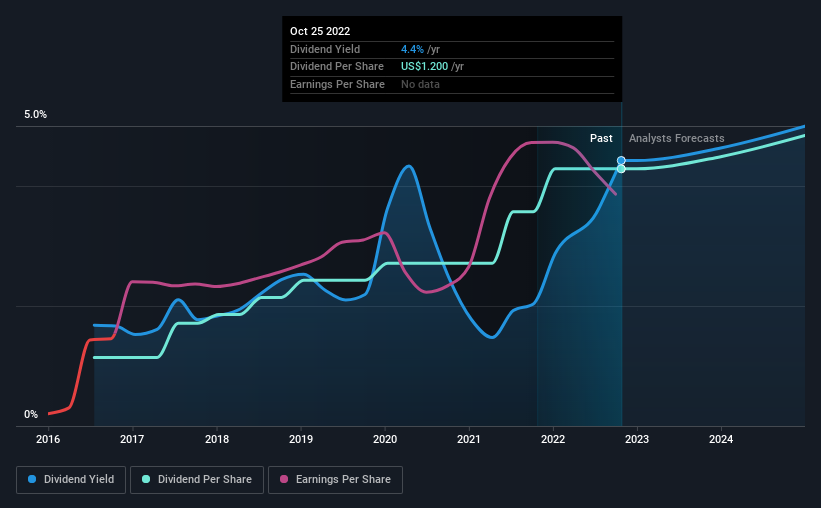Ally Financial Inc. (NYSE:ALLY) stock is about to trade ex-dividend in four days. The ex-dividend date is usually set to be one business day before the record date which is the cut-off date on which you must be present on the company's books as a shareholder in order to receive the dividend. The ex-dividend date is important as the process of settlement involves two full business days. So if you miss that date, you would not show up on the company's books on the record date. Meaning, you will need to purchase Ally Financial's shares before the 31st of October to receive the dividend, which will be paid on the 15th of November.
The company's upcoming dividend is US$0.30 a share, following on from the last 12 months, when the company distributed a total of US$1.20 per share to shareholders. Looking at the last 12 months of distributions, Ally Financial has a trailing yield of approximately 4.4% on its current stock price of $27.12. If you buy this business for its dividend, you should have an idea of whether Ally Financial's dividend is reliable and sustainable. We need to see whether the dividend is covered by earnings and if it's growing.
Dividends are typically paid out of company income, so if a company pays out more than it earned, its dividend is usually at a higher risk of being cut. Ally Financial has a low and conservative payout ratio of just 19% of its income after tax.
Companies that pay out less in dividends than they earn in profits generally have more sustainable dividends. The lower the payout ratio, the more wiggle room the business has before it could be forced to cut the dividend.
Click here to see the company's payout ratio, plus analyst estimates of its future dividends.

Have Earnings And Dividends Been Growing?
Businesses with strong growth prospects usually make the best dividend payers, because it's easier to grow dividends when earnings per share are improving. Investors love dividends, so if earnings fall and the dividend is reduced, expect a stock to be sold off heavily at the same time. It's encouraging to see Ally Financial has grown its earnings rapidly, up 24% a year for the past five years.
Another key way to measure a company's dividend prospects is by measuring its historical rate of dividend growth. Ally Financial has delivered an average of 25% per year annual increase in its dividend, based on the past six years of dividend payments. It's great to see earnings per share growing rapidly over several years, and dividends per share growing right along with it.
The Bottom Line
Is Ally Financial an attractive dividend stock, or better left on the shelf? Companies like Ally Financial that are growing rapidly and paying out a low fraction of earnings, are usually reinvesting heavily in their business. Perhaps even more importantly - this can sometimes signal management is focused on the long term future of the business. We think this is a pretty attractive combination, and would be interested in investigating Ally Financial more closely.
On that note, you'll want to research what risks Ally Financial is facing. Our analysis shows 3 warning signs for Ally Financial that we strongly recommend you have a look at before investing in the company.
Generally, we wouldn't recommend just buying the first dividend stock you see. Here's a curated list of interesting stocks that are strong dividend payers.
Have feedback on this article? Concerned about the content? Get in touch with us directly. Alternatively, email editorial-team (at) simplywallst.com.
This article by Simply Wall St is general in nature. We provide commentary based on historical data and analyst forecasts only using an unbiased methodology and our articles are not intended to be financial advice. It does not constitute a recommendation to buy or sell any stock, and does not take account of your objectives, or your financial situation. We aim to bring you long-term focused analysis driven by fundamental data. Note that our analysis may not factor in the latest price-sensitive company announcements or qualitative material. Simply Wall St has no position in any stocks mentioned.
The views and opinions expressed herein are the views and opinions of the author and do not necessarily reflect those of Nasdaq, Inc.


